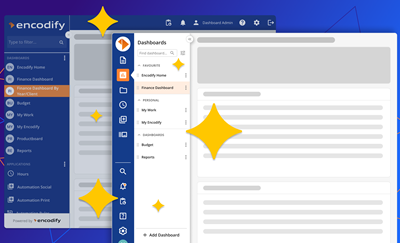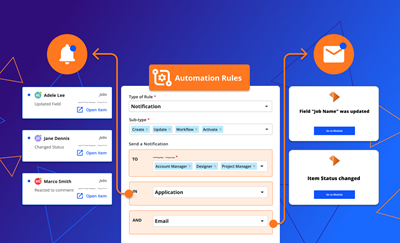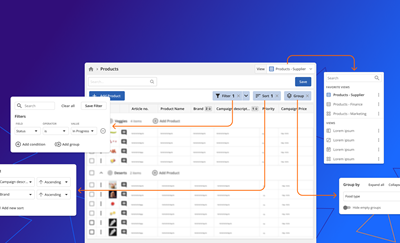9 insights from NRF 2021 Retail’s Big Show to drive success in 2021
Encodify
12 min read

As we dive into 2021, one thing is certain: retailers must continue to move quickly in their digital transformation and be ready for change.
Drive success in 2021
As we dive into 2021, one thing is certain: retailers must continue to move quickly in their digital transformation and be ready for change. Our Product Director, Stuart Lynch, attended NRF 2021 Retail's Big Show over two full weeks. Below, he shares his insights on what retailers must consider fueling customer engagement, brand loyalty and growth in 2021.
IT WAS GREAT HEARING FROM THE BEST RETAILERS IN THE WORLD and how they are adapting to all of the change and unprecedented challenges that the last 12 months have brought to the industry. Five years of commerce transformation has happened in 8 months because it was necessary to meet consumers where they are.
Just a quick note on NRF, or National Retail Federation, the host of this massive event. NRF is the world’s largest retail trade organisation. It’s based in the US, where retail contributes $3.9 trillion to the annual GDP. This year’s show was not a live event because of Covid-19, but it was big nevertheless - as in very big. More than 330 speakers participated in 100 sessions to share lessons learned from the past year and thoughts on the optimistic road ahead.
The themes and subjects discussed in this event vary a lot, obviously, but I would like to share with you some of the most pressing and interesting issues that need to be addressed now. And, if reading this makes you wonder how your business is coping with agility, a strong technology foundation, a hybrid workforce, connected commerce, and more, please get in touch with us. We are addressing these issues every day with retailers of different sizes. We could help you, too.
You need a sound, solid foundation. Two years ago, we couldn’t offer a customer an e-receipt. We couldn’t set up a schedule for associates in the stores that worked for both customer demand and the associates’ lifestyle. The eCommerce platform was running on a decade-old infrastructure. Our job was to put the foundation in place, so the superstructure could grow quickly and be stable.
1. Importance of a strong technology foundation
“It’s like building a home,” Marvin Ellison said. He is president and CEO of Lowe’s and he spoke to NRF president and CEO Matthew Shay. It turned out to be a perfect tale of how important a strong technology foundation is. Lowe’s serves 18 million customers every week. And as Marvin Ellison recounted:
“You need a sound, solid foundation. Two years ago, we couldn’t offer a customer an e-receipt. We couldn’t set up a schedule for associates in the stores that worked for both customer demand and the associates’ lifestyle. The ecommerce platform was running on a decade-old infrastructure. Our job was to put the foundation in place, so the superstructure could grow quickly and be stable.”
The case of Lowe’s is not only important because it shows the need to evaluate your technology foundation. It is specifically interesting because it goes hand in hand with the need to be an omnichannel business, and it is a prerequisite for being agile, and thus being able to respond much quicker in times of a major disruption like Covid-19. It makes so much reason to hear a story like Lowe’s when you are working at Encodify. We equip clients with a foundational platform that works like a glue between older technology stack and new components. We help you build that superstructure.
2. The Great Compression
Is this the next Great Depression or is this The Great Compression? Ecommerce was 15 percent of all commerce prior to the pandemic. It then soared to close to 50 percent. Something extraordinary took place in the retail landscape last year - perhaps for good. Mitch Joel, journalist and founder of Six Pixels Group, Inc., dubbed this strange moment in time the “Great Compression”.
“What we’ve seen is a true acceleration of digital transformation, in terms of innovation and in terms of where the world is at,” he said. “Everything has compressed.”
The Great Compression is our new reality: During the short span of a few months, consumer's buying behaviour fundamentally shifted. Physical retail stores are now forced to think less about the "experience" and more about how to get consumers to transact. DTC and online retailers are now forced to think about not just getting consumers to buy, but how to build a better shopping experience. We have everyone from pre-kindergarten children to our most elderly now fully-digitised, online and ordering.
How do retailers rethink many of their commonly held beliefs about what works in commerce today, and what the future may look like? Welcome to The Great Compression.
At the centre of it all is a wave that at first seemed unnavigable a year ago, when retailers were forced into sudden adjustment. Then we managed to get on top of the wave, not drowning, but not fully sure how to remain on top of the wave. But we are survivors, and we understand that we can accommodate the sudden changes if we want to. Most have stabilised their businesses by now, but everyone is looking for a sustainable way to navigate the wave. One thing we feel quite sure about here at Encodify is this: This is not the last wave to hit us. But we can be better prepared next time.
3. Flexibility and agility
The need to be able to pivot and be ready for whatever's coming - be it another pandemic, be it changes in consumer sentiment or behaviour and the way that cloud technologies in particular facilitate this agility in the face of whatever may come up.
There was one session on how to make data-driven decisions. Here John Louglin, Chief Technologist at Cloudreach, shared three key points which I find useful to repost:
All data should be stored and available in its raw form: With some businesses it might be impossible to store all the data, but the point is to keep as much of it as you can and then it should be catalogued so you have an inventory of the assets.
Data should be cataloged - an inventory of data assets helps break down organisational silos; Then it will be possible to get rid of organisational silos because everybody has access to the pools and can look at the index to understand what's available for them to leverage.
The various forms of analytics - descriptive, predictive, and prescriptive.
John Louglin’s third main point was that with these two things as a foundation you can really move your analytics from what happened (descriptive), to why did it happen (diagnostic) and then into true insight which is what will happen (predictive) and ultimately to what should we do (prescriptive) - and that's the maximum business value that comes from this.
By going through that journey, and by setting up your data stores correctly, the cloud allows you to do this at scale.
4. Focus on creating new revenue streams
The pandemic made a lot of disruption, and it made some retailers take a different path or rather venture into new territory. For instance, drug store chain, Walgreens, with more than 9.000 shops across North America, will offer a growing list of financial products for customers this year. This will include a co-branded credit card and a prepaid debit card.
Likewise, in the UK, the John Lewis Partnership has announced plans to reach more customers in a variety of different initiatives. The U.K.’s largest employee-owned business is for instance moving into housing with 20 sites that the business already owns identified for the development of sustainable housing developments.
And in Denmark, where Encodify is headquartered, we have experienced a similar thing with retail giant Coop getting serious about banking and lately mortgage loans.
From an Encodify point of view I should say that it is quite important to remember to consider how you manage everything, once you add a new business string to your retail orchestra. This is where an Encodify platform makes sense. Because you can strengthen your overview. You can use automation smartly. And you can get in control of your marketing activities. A platform can not only manage your promotional and ecommerce activities but also campaigns and content for services and non-retail activities.
5. Power of connected commerce
As consumers return to physical stores, how can retailers build end-to-end transactional experiences that users will find comfortable and safe? Some like Verizon-- a veritable lifeline for consumers-- began recreating the minute COVID-19 hit; others like Suitsupply had more time to shape the next normal.
There is no one-size-fits-all approach, but priorities are remarkably similar: Meet customers where they want to shop, build out digital solutions so that consumers can stay connected even when they can't physically engage and embrace a frictionless experience. It is not an easy achievement to actually accommodate customer expectations of highly connected, frictionless digital experiences. But you need to remap the customer experience.
6. Sustainability - values are being valued by the consumer
Being a socially responsible company is no longer a point of distinction as it is an expectation from consumers and stakeholders. Former CEO and chair of Pepsi, Indra Nooyi, talked about how healthier and sustainable lives fall upon us as individuals and everybody across the supply chain. It’s everybody’s responsibility to help us promote a healthier and more sustainable society.
Some companies, like IKEA, have shown the way during the pandemic using Black Friday to promote reused furniture. As a front runner for the case of circular economy, IKEA is clearly embracing the trend of values being valued by the consumer. It’s not just corporate doing good, it is a workplace, a business and a member of society that acts upon the issue of responsibility. And retailers are following suit. You need to align corporate values with intentional policies and practices that encourage responsibility, diversity, equality and equity.
7. DTC Brands disrupting the market
Retail has gone through a monumental shift during the last ten years. The shopping experience is reflected in what is convenient and easy for the consumer, rather than the retailer. It’s a matter of removing what’s in between the manufacturer and the customer, be it marketplaces, third-party retailers or middlemen.
And during lockdown, some companies made a point of growing its ecommerce business considerably because conditions forced them to. And they succeeded. Unilever’s ecommerce grew by 61% in 2020 and it was made possible by consumer insight. As a key element in the FMCG giant’s future development, growing the direct to consumer business is a matter of keeping up with fast-changing consumer behaviour. To do that you need advanced shopper insight, as Unilever puts it.
Here at Encodify we have followed this trend with great interest, simply because our platform is adaptable. It can be altered to meet the changing needs of retailers, because it is possible to develop relevant tools and/or integrate existing tools. When DTC brands look for faster time to market, we can support the ambition with limitless integration possibilities and automated workflows. We call it innovation at speed.
8. Stores are not going away
Brick and mortar stores are here to remain. The questions are rather: how will they be staffed, how will they be equipped and what will be their role? New store formats that incorporate new health and safety changes baked into the format.
Take the example of the dark store. While not itself a technology, dark stores are the result of retail technological advancement. These physical hubs are dedicated to e-commerce but allow for associates to be on the floor showcasing products. With the addition of live video, associates are able to connect with shoppers safely and allow them to feel more empowered about making a significant purchase. It offers a level of personalised service only previously achieved inside the store. Dark stores are local fulfilment centres allowing retailers to ship products more quickly.
In essence, stores are not just hubs of selling wares. Stores are also experience hubs and fulfilment hubs.
9. Hybrid workforce
“The strength of an organisation’s culture was called to task during the last four quarters,” Chewy CEO Sumit Singh said. Chewy reevaluated team dynamics and discovered a hybrid model of remote and in-person work which accommodated its shoppers and actually worked for the workforce. Retail has changed. The customers have changed. And so, the concept of the retail store and its workforce has to change with it.
The yoga-inspired retail chain Lululemon was showcased on NRF as the great example of how, during 2020, a retail chain was able to take advantage of all the investments made in the digital ecosystem. You could say that Lululemon exemplified the concept of agility and it was made possible by “three years’ worth of investment pre-pandemic”.
Lululemon, as it turned out last year, was able to fully embrace the customer centric approach for instance by creating virtual waitlists, that keeps customers from having to stand outside of stores and wait 30 minutes or more before entering. Or embrace omnichannel by setting up 106 pop up stores during the last months of 2020, often close to permanent stores, to accommodate being more accessible to the customers.
Retail executives need to consider employing a workforce which is able to switch between work and home, office and out of office. Commerce is ecommerce and vice versa. Commerce will be a hybrid of online and offline, and the workforce will obviously need to adapt to this, too. A hybrid commerce environment will be reflected in a hybrid working environment, and, I should add, the tools to manage this new normal are really very important. The digital solutions to match a hybrid working environment are crucial: Get employees to be agile and more productive by reducing friction on the employee side. Once they can easily access the tools and information they need to complete their jobs, you can win the battle of hybrid commerce. Yes, we have the tools here at Encodify, and we see a match with this growing hybrid workforce.











